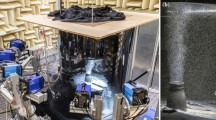Abstract
Positron emission particle tracking (PEPT) is increasingly used to understand the flow characteristics in complex systems. This research utilizes PEPT to measure pulsatile flow of frequency 2.1 Hz in an elastic Masterkleer PVC tube of 19 mm inner diameter and 3.2 mm wall thickness. Anion exchange resin beads are labeled with 18F and delivered to a pump driven flow loop with motorized ball valve used to develop the pulsatile flow. Data are collected in the tube with circular cross section, and measurements are also collected with a section of the tube pinched. Nominal flow velocities are near 1 m/s and Reynolds numbers near 20,000. Many thousand PEPT particle traces are collected and synchronized with the flow pulsation. These Lagrangian data are presented as a series of 20 still frames depicting the 3-D velocity field present during each phase of the flow pulsation. Pressure data are also collected to resolve the pressure wave front moving through the open elastic tube at velocity 15.2 m/s.











Similar content being viewed by others
Notes
MATLAB R2015a and R2016a (MathWorks, Inc., Natick, MA, 2015 and 2016).
References
Bao Q, Chen M, Stout D, Chatziioannous A, Newport D (2009) Performance evaluation of the inveon dedicated PET preclinical tomograph based on the NEMA NU-4 standards. J Nucl Med 50(3):401–408. doi:10.2967/jnumed.108.056374
Benam A, Shadpour M, Fatouraee N, Pashaiee A, Khani M (2008) A new system to analyze pulsatile flow characteristics in elastic tubes for hemodynamic applications. Am J Appl Sci 5(12):1730–1736. doi:10.3844/ajassp.2008.1730.1736
Bickell M, Buffler A, Govender I, Parker D (2012) A new line density tracking algorithm for PEPT and its application to multiple tracers. Nucl Instrum Methods Phys Res 82:36–41. doi:10.1016/j.nima.2012.04.037
Buther F, Dawood M, Stegger L, Wübbeling F, Schäfers M, Schober O, Schäfers KP (2009) List mode-driven cardiac and respiratory gating in PET. J Nucl Med 50(5):674–681. doi:10.2967/jnumed.108.059204
Chang Y, Hoffmann A (2015) A Lagrangian study of liquid flow in a reverse-flow hydrocyclone using positron emission particle tracking. Exp Fluids 56(1):1–14. doi:10.1007/s00348-014-1875-5
Crocker J, Grier D (1996) Methods of digital video microscopy for colloidal studies. J Colloid Interface Sci 179(1):298–310. doi:10.1006/jcis.1996.0217
Geers AJ, Larrabide I, Radaelli AG, Bogunovic H, Kim M, Gratama van Andel HA, Majoie CB, VanBavel E, Frangi AF (2011) Patient-specific hemodynamics of intracranial aneurysms from 3D rotational angiography and CT angiography: an in vivo reproducibility study. Am J Neuroradiol 32(3):581–586. doi:10.3174/ajnr.A2306
Ha H, Hwang D, Kim GB, Kweon J, Lee SJ, Baek J, Kim YH, Kim N, Yang DH (2016) Estimation of turbulent kinetic energy using 4D phase-contrast MRI: effect of scan parameters and target vessel size. Magn Reson Imaging 34:715–723. doi:10.1016/j.mri.2016.03.008
Hassan YA, Canaan RE (1991) Full-field bubbly flow velocity measurements using a multiframe particle tracking technique. Exp Fluids 12:49–60. doi:10.1007/BF00226565
Hoffman AC, Dechsiri C, van de Wiel F, Dehling HG (2005) PET investigation of a fluidized particle: spatial and temporal resolution and short term motion. Meas Sci Technol 16:851–858. doi:10.1088/0957-0233/16/3/029
Kuhn HW (1955) The Hungarian method for the assignment problem. Nav Res Logist Q 2:83–97.
Kuhn HW (1956) Variants of the Hungarian method for assignment problems. Nav Res Logist Q 3:253–258.
Moody F J (1990) Introduction to unsteady thermofluid mechanics. Wiley-Interscience. ISBN-10: 047185705X
Mordant N, Crawford AM, Bodenschatz E (2004) Experimental Lagrangian acceleration probability density function measurement. Physica D 193:245–251. doi:10.1016/j.physd.2004.01.041
Munkres J (1957) Algorithms for the assignment and transportation problems. J Soc Ind Appl Math 5(1):32–38
Parker D, Fan X (2008) Positron emission particle tracking-application and labelling techniques. Particuology 6(1):16–23. doi:10.1016/j.cpart.2007.10.004
Parker D, Broadbent C, Fowles P, Hawkesworth M, Mcneil P (1993) Positron emission particle tracking-a technique for studying flow within engineering equipment. Nucl Instrum MethodS Phys Res A 326(3):592–609. doi:10.1016/0168-9002(93)90864-E
Randles A, Draeger EW, Bailey PE (2015) Massively parallel simulations of hemodynamics in the primary large arteries of the human vasculature. J Comput Sci 9:70–75. doi:10.1016/j.jocs.2015.04.003
Sbalzarini I, Koumoutsakos P (2005) Feature point tracking and trajectory analysis for video imaging in cell biology. J Struct Biol 151(2):182–195. doi:10.1016/j.jsb.2005.06.002
Shaw R F (1980) Signalling particles for introduction into blood flowing in a vessel of interest. US Patent 4,224,203.
Tai YC, Chatziioannou A, Siegel S, Young J, Newport D, Goble RN, Nutt RE, Cherry SR (2001) Performance evaluation of the microPET P4: a PET system dedicated to animal imaging. Phys Med Biol 46:1845–1862. doi:10.1088/0031-9155/46/7/308
Usmani AY, Muralidhar K (2016) Pulsatile flow in a compliant stenosed asymmetric model. Exp Fluids 57:186. doi:10.1007/s00348-016-2274-x
Wiggins C, Santos R, Ruggles A (2016) A novel clustering approach to positron emission particle tracking. Nucl Instrum Method Phys Res A 811:18–24. doi:10.1016/j.nima.2015.11.136
Wiggins C, Santos R, Ruggles A (2017) A feature point identification method for positron emission particle tracking with multiple tracers. Nucl Instrum Methods Phys Res A 843:22–28. doi:10.1016/j.nima.2016.10.057
Yang Z, Parker D, Fryer P, Bakalis S, Fan X (2006) Multiple-particle tracking—an improvement for positron particle tracking. Nucl Instrum Methods Phys Res 564(1):332–338. doi:10.1016/j.nima.2006.04.054
Acknowledgements
The authors appreciate NNSA Stewardship Sciences Academic Programs (SSAP) for supporting this research. This material is based upon work supported under an Integrated University Program Graduate Fellowship. The authors thank Alan Stuckey of University of Tennessee Medical Center for providing the 18F used in these experiments and Howard Cyr for giving us access to Mastersizer 3000 laser particle size analyzer.
Author information
Authors and Affiliations
Corresponding author
Electronic supplementary material
Below is the link to the electronic supplementary material.
Rights and permissions
About this article
Cite this article
Patel, N., Wiggins, C. & Ruggles, A. Positron emission particle tracking in pulsatile flow. Exp Fluids 58, 42 (2017). https://doi.org/10.1007/s00348-017-2330-1
Received:
Revised:
Accepted:
Published:
DOI: https://doi.org/10.1007/s00348-017-2330-1




